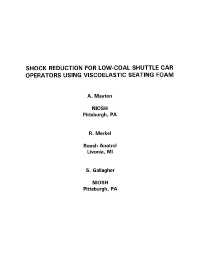Mining Publication: Shock Reduction for Low-Coal Shuttle Car Operators Using Viscoelastic Seating Foam
Original creation date: March 1998
The prolonged exposure of equipment operators to shock and whole-body vibration (WBV) is linked to cumulative back, neck, and abdominal disorders. In low-coal mines, space restrictions make seat suspensions difficult to use in isolating operators from shock and WBV. Researchers at NIOSH, Pittsburgh Research Laboratory, are responding to these issues by investigating viscoelastic foams. For the full-load case, an ergonomic seat with viscoelastic foams isolated the shuttle car operator from shock at 15Hz. Researchers used results from additional foam testing with an analytical model to identify viscoelastic foams that provide shock isolation at a frequency below 5Hz.
Authors: AG Mayton, R Merkel, S Gallagher
Conference Paper - March 1998
NIOSHTIC2 Number: 20000107
Society for Mining, Metallurgy, and Exploration Annual Meeting, SME preprint 98-44, Littleton, CO, Society for Mining, Metallurgy, and Exploration, Inc., 1998 Mar; :1-4
See Also
- Acceleration and GPS Data Monitor Truck-Haulage Jolts
- Comfort Evaluation for Mine Shuttle Car Seat Designs
- Ergonomic Seat With Viscoelastic Foam Reduces Shock on Underground Mobile Equipment
- Improved Seat Reduces Jarring/Jolting for Operators of Low-Coal Shuttle Cars
- Investigation of Ampacity Derating Factors for Shuttle Cars Using Fiber Optics Technology
- Laboratory Investigation of Seat Suspension Design Performance during Vibration Testing
- Physiological Responses and Subjective Discomfort of Simulated Whole-Body Vibration From a Mobile Underground Mining Machine
- Systematic Comparison of Different Seats on Shuttle Cars Used in Underground Coal Mines
- Whole-Body Vibration and Postural Stress among Operators of Construction Equipment: A Literature Review
- Whole-Body Vibration Exposure Comparison of Seat Designs for Low- and Mid-Seam Shuttle Cars in Underground Coal Mines
- Page last reviewed: 6/14/2016
- Page last updated: 6/14/2016
- Content source: National Institute for Occupational Safety and Health, Mining Program


 ShareCompartir
ShareCompartir
